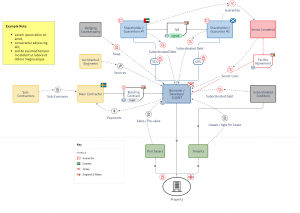Lawyers may be the only professionals who routinely rely on dense text to understand complicated ideas. And that could change for transaction lawyers with the release of StructureFlow to diagram and track complex deals. Before I report on this product, based on a conversation with Founder and CEO Tim Follett, some background.
[As with all my product-specific blog posts, this is neither a review nor a product comparison. I occasionally write about products that I think do something new or something differently enough to be interesting. I first published this article at my blog on 4 May 2020.]
In all my jobs, visual displays have played key roles and I regularly blog about visual intelligence. As an economic and financial analyst after college, I regularly created time series, cross-sectional, and 2×2 portfolio displays. That was before PCs and required programming. After law school, I was a Bain & Company consultant. Bain never wrote reports. It only presented to clients with slide decks. The company employed an army of graphic artists to hand produce multi-color overhead slides (which required Xacto-ing tiny colored acetate sections.)
These stories date me. And illustrate that professionals have long invested to create graphics to inform and advise. And some lawyers do so. My first published article was “Practicing Law with Pictures”. That was about 1992 in Law Technology Product News, today Legal Tech News. (I wish I had a paper or digital copy.)
In it, I showed several visual displays from my firm’s practice. I still remember two examples. One diagrammed regulating commercial banks versus bank holding companies. My firm visually illustrated an adversary’s interpretation of the law, which made clear the implications of its argument. The partner credited that diagram with winning the dispute. A second was a transaction diagram. The lawyer on the deal said “Until I diagramed the transaction, I did not really understand the deal.”
And here we are 25+ years later and transaction diagrams remain far from routine. Beyond any mindset issues, using PowerPoint or equivalent to create them is time-consuming and painful.
And that brings us to StructureFlow, which is purpose built to diagram – and document – deals. Here is an example of its visualization:

Looking at it, I understand quickly the deal elements. I cannot imagine how long that would take reading the deal documents or even a transaction summary.
Tim showed me how to create and document a diagram. The interface seems easy and elegant.
Adding, editing, and moving nodes is easy and StructureFlow maintains connection lines as you move around nodes. It is way easier than PowerPoint. Adding deal data is also easy using a sidebar with fields specific to either the node or the connector.
I see many benefits for deal diagrams. It helps lawyers and legal professionals understand what’s happening at the macro level, with the ability to drill down to the micro. The initial product release allows linking nodes and connectors to relevant documents in a document management system.
Because StructureFlow is cloud based, anyone viewing the deal diagram will see the current version. Tim emphasized that a single source of truth in the cloud avoids a problem he regularly experienced as a deal lawyer: out-of-date PowerPoint diagrams. Another nice feature is an audit trail of who changed what and how. (StructureFlow is hosted on Azure, is ISO 27001 compliant,and can be set-up in single tenancy without shared resources.)
StructureFlow will also integrate with transaction management platforms – it is not trying to compete with them but rather sees itself as part of the deal management ecosystem.
That StructureFlow can capture deal terms potentially simplifies creating records in deal databases and experience management systems. Some firms invest considerable non-billable resources to capture deal points (sometimes in excess of 100). I think that it’s an open question if lawyers using StructureFlow will diligently complete all the data fields. But even if they don’t, I suspect the deal diagram and links to documents would make finding the deal terms faster for a knowledge manager or other legal professional charged with extracting and recording deal points.
I would be remiss not to mention the #DoLessLaw benefits of StructureFlow. DoLessLaw refers to efficiency and effectiveness in law practice, for example, scoping, project management, delegation to lower cost resources, and technology for efficiency. I regularly blog and Tweet about DoLessLaw.
Lawyers spend much time – perhaps too much – tracking and managing information. A clear and always-current transaction diagram, with links to key documents, can save time by reducing cognitive load and mechanical work. The deal structure stays clear and finding documents is faster. Diagrams also aid in training lawyers. Imagine the difference in explaining the transaction pictured above to a 1st year associate with and without the diagram.
A second DoLessLaw benefit centers around disputes. Diagrams may help avoid disputes. Lawyers may have no problem grasping complex deals but their business clients might like some support. They will welcome a diagram that explains the overall deal, and their part in it. Separately, should a completed deal become the subject of litigation, the diagram could help a mediator, arbitrator, or judge understand what happened and what went wrong. And this could help resolve a dispute more quickly and at less cost.
In closing, I need to mention that especially during the COVID crisis and lockdown, when lawyers cannot assemble to discuss deals, I can see that sharing the deal overview via a visual sitting on the cloud will be especially valuable. And adoption of this type of tool is an example of what I had in mind when I wrote Will the COVID Crisis Change How Lawyers Collaborate? (Legal IT Insider, 14 April 2020) My point there was that the crisis could be a pivot point after which lawyers practice differently – and better. I certainly think using StructureFlow would improve deal practice.
[You can learn more about how StructureFlow helps with deals via a four-minute video Tim created, accessible at his LinkedIn profile.]
